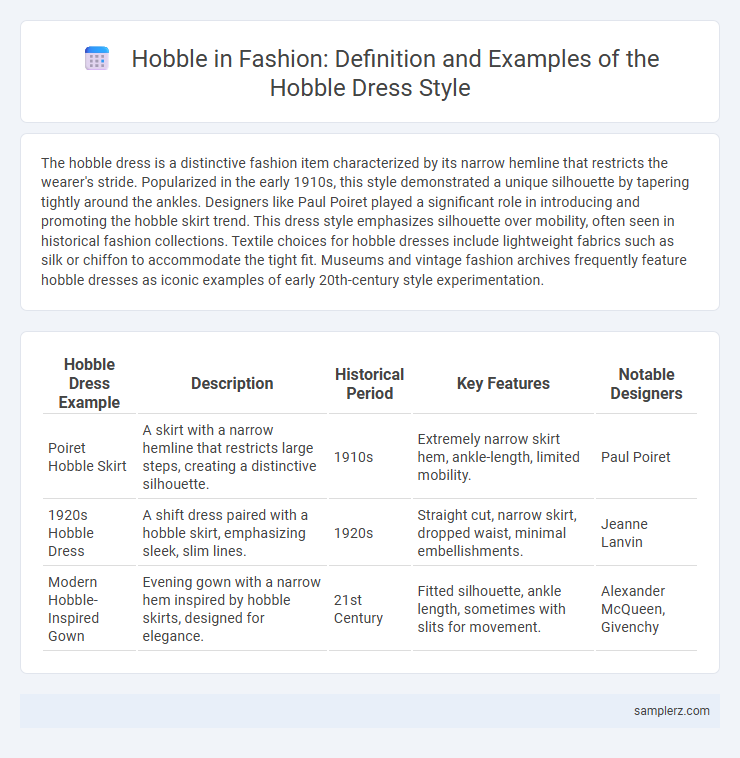The hobble dress is a distinctive fashion item characterized by its narrow hemline that restricts the wearer's stride. Popularized in the early 1910s, this style demonstrated a unique silhouette by tapering tightly around the ankles. Designers like Paul Poiret played a significant role in introducing and promoting the hobble skirt trend. This dress style emphasizes silhouette over mobility, often seen in historical fashion collections. Textile choices for hobble dresses include lightweight fabrics such as silk or chiffon to accommodate the tight fit. Museums and vintage fashion archives frequently feature hobble dresses as iconic examples of early 20th-century style experimentation.
Table of Comparison
| Hobble Dress Example | Description | Historical Period | Key Features | Notable Designers |
|---|---|---|---|---|
| Poiret Hobble Skirt | A skirt with a narrow hemline that restricts large steps, creating a distinctive silhouette. | 1910s | Extremely narrow skirt hem, ankle-length, limited mobility. | Paul Poiret |
| 1920s Hobble Dress | A shift dress paired with a hobble skirt, emphasizing sleek, slim lines. | 1920s | Straight cut, narrow skirt, dropped waist, minimal embellishments. | Jeanne Lanvin |
| Modern Hobble-Inspired Gown | Evening gown with a narrow hem inspired by hobble skirts, designed for elegance. | 21st Century | Fitted silhouette, ankle length, sometimes with slits for movement. | Alexander McQueen, Givenchy |
Origins of the Hobble Skirt in Fashion History
The hobble skirt, characterized by its narrow hem restricting stride, originated in the early 1910s as a daring silhouette that challenged traditional women's fashion. Influenced by designer Paul Poiret, the hobble skirt emphasized a slender, elongated form, drawing inspiration from both Eastern garments and the social desire for elegance combined with subtle constraints. Its popularity marked a significant shift in fashion history, reflecting changes in women's roles and aesthetics before World War I.
Key Designers Who Popularized the Hobble Dress
Paul Poiret is widely recognized for popularizing the hobble dress in the early 1910s, restricting movement with its narrow hemline that emphasized an elegant, elongated silhouette. Jeanne Lanvin and Mariano Fortuny also contributed to the hobble dress trend, blending luxurious fabrics with innovative cuts that highlighted the dress's unique constriction. Their designs influenced the fashion industry by challenging conventional freedom of movement, making the hobble dress a symbol of avant-garde style during the pre-World War I era.
Distinctive Features of Hobble Dresses
Hobble dresses are characterized by their narrow, tapered skirts that significantly restrict leg movement, creating a unique walking style. Typically featuring a fitted bodice and a tightly cinched waist, these dresses accentuate the silhouette while maintaining an elegant yet restrictive form. The distinctive hobble skirt length often falls below the knee, emphasizing the limited stride that defines this iconic fashion piece.
Iconic Hobble Dress Moments on the Runway
The iconic hobble dress, characterized by its narrow hem restricting stride, made unforgettable appearances on fashion runways, notably in Christian Dior's 1947 New Look collection that redefined post-war elegance. Designers like Vivienne Westwood have revived the hobble silhouette with modern twists, showcasing its blend of vintage charm and contemporary edge. These runway moments celebrate the hobble dress as a symbol of refined femininity and daring design innovation.
How Hobble Skirts Influenced Women's Mobility
Hobble skirts, popularized in the early 1910s, dramatically restricted women's stride due to their narrow hemline, significantly limiting physical movement and reshaping societal perceptions of femininity. This style emphasized a delicate and constrained silhouette, symbolizing the tension between fashion and functional mobility during the Edwardian era. The hobble skirt's impact on women's fashion highlighted the growing discourse on balancing aesthetic appeal with practical comfort in garment design.
Modern Interpreations of the Hobble Style
Modern interpretations of the hobble style in fashion emphasize sleek, narrow silhouettes that restrict leg movement akin to the original early 20th-century design. Designers incorporate hobble-inspired skirts and dresses using stretchy fabrics and strategic slits to balance comfort with the iconic constricted look. This fusion of historical influence and contemporary practicality revitalizes the hobble dress as a statement of both elegance and innovation.
Famous Celebrities Who Wore Hobble Dresses
Famous celebrities such as Marlene Dietrich and Audrey Hepburn popularized hobble dresses, known for their narrow hems that restrict movement and create a distinctive silhouette. These iconic figures showcased the elegance and allure of hobble skirts on red carpets and film, making them a symbol of vintage glamour. Modern designers occasionally revive the hobble dress to evoke old Hollywood sophistication in contemporary fashion collections.
How to Style a Hobble Dress Today
Styling a hobble dress today involves balancing its restrictive silhouette with modern elements like sleek ankle boots or pointed-toe heels to enhance mobility and elegance. Pairing the dress with a cropped leather jacket or a structured blazer adds a contemporary edge while maintaining the vintage charm of the narrow hemline. Accessorize with minimalist jewelry and a compact clutch to keep the focus on the dress's dramatic, tapered shape.
Cultural Impact of the Hobble Skirt Era
The hobble skirt, characterized by its narrow hem restricting stride, revolutionized early 20th-century fashion by symbolizing both elegance and female constraint. Its cultural impact was profound, reflecting societal tensions around women's mobility and independence during the Edwardian era. This garment became an iconic representation of the complexities surrounding gender roles and the evolving perceptions of femininity in fashion history.
Fabrics Commonly Used in Hobble Dress Designs
Hobble dresses frequently utilize fabrics such as silk, satin, and taffeta to achieve the structured, restrictive silhouette characteristic of the style. These materials provide both the necessary stiffness and luxurious sheen, enhancing the dress's elegant yet restrictive appeal. Velvet and brocade are also popular choices, offering textured depth while maintaining the hobble skirt's narrow, constricted shape.

example of hobble in dress Infographic
 samplerz.com
samplerz.com